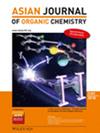共价连接三联吡啶-BODIPY和三联吡啶-3-吡咯基BODIPY共轭物的合成及性质
IF 2.8
4区 化学
Q1 CHEMISTRY, ORGANIC
引用次数: 0
摘要
通过在BODIPY(3-4)和3-吡啶BODIPY核心(5-7)的α和/或中间位上调整三吡啶部分的位置,合成了一系列共价连接的三吡啶-BODIPY和三吡啶-3-吡啶BODIPY缀合物。这些化合物经过一系列合成步骤合成,并通过其中一个共轭物的HR-MS, 1D, 2D NMR和x射线晶体学证实了它们的身份,并通过各种光谱,电化学和理论技术进行了研究。三吡啶基团在BODIPY和3-吡咯基BODIPY核上的存在显著地改变了它们的电子性质,并且这些共轭物在505 - 640nm区域有很强的吸收。此外,α-三吡啶基3-吡咯基BODIPY缀合物被用作配体,形成异电性钌(II/III)配合物。Ru(II)/Ru(III)配合物表现出微弱的荧光,由于Ru(II)/Ru(III)离子的存在显著降低了量子产率和单态寿命,增强了自旋轨道耦合,增加了系统间交叉(ISC)的速率,导致非辐射弛豫。DFT和TD-DFT研究证实了我们的实验发现,为这些共轭物的结构、光物理和电子特性提供了更深入的见解。本文章由计算机程序翻译,如有差异,请以英文原文为准。
Synthesis and Properties of Covalently Linked Terpyridine‐BODIPY and Terpyridine‐3‐Pyrrolyl BODIPY Conjugates
A series of covalently linked terpyridine‐BODIPY and terpyridine‐3‐pyrrolyl BODIPY conjugates were synthesized by strategically tuning the position of the terpyridine moiety at the α and/or meso positions of the BODIPY (3–4) and 3‐pyrrolyl BODIPY cores (5–7). These compounds were synthesized over a sequence of synthetic steps and their identities were confirmed by HR‐MS, 1D, 2D NMR, and X‐ray crystallography of one of the conjugates and studied by various spectroscopic, electrochemical, and theoretical techniques. The presence of terpyridine moieties on BODIPY and 3‐pyrrolyl BODIPY cores significantly alters their electronic properties and these conjugates absorb strongly in the 505–640 nm region. Furthermore, the α‐terpyridinyl 3‐pyrrolyl BODIPY conjugate was used as a ligand to form heteroleptic ruthenium(II/III) complexes. The Ru(II)/Ru(III) complexes exhibit weak fluorescence with significantly reduced quantum yield and single‐state lifetime due to the presence of a heavy Ru(II)/Ru(III) ion, which enhances spin‐orbit coupling and increases the rate of intersystem crossing (ISC), leading to non‐radiative relaxation. DFT and TD‐DFT studies corroborated our experimental findings, providing deeper insights into the structural, photophysical, and electronic properties of these conjugates.
求助全文
通过发布文献求助,成功后即可免费获取论文全文。
去求助
来源期刊

Asian Journal of Organic Chemistry
CHEMISTRY, ORGANIC-
CiteScore
4.70
自引率
3.70%
发文量
372
期刊介绍:
Organic chemistry is the fundamental science that stands at the heart of chemistry, biology, and materials science. Research in these areas is vigorous and truly international, with three major regions making almost equal contributions: America, Europe and Asia. Asia now has its own top international organic chemistry journal—the Asian Journal of Organic Chemistry (AsianJOC)
The AsianJOC is designed to be a top-ranked international research journal and publishes primary research as well as critical secondary information from authors across the world. The journal covers organic chemistry in its entirety. Authors and readers come from academia, the chemical industry, and government laboratories.
 求助内容:
求助内容: 应助结果提醒方式:
应助结果提醒方式:


